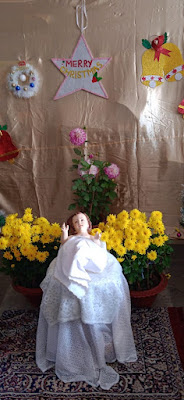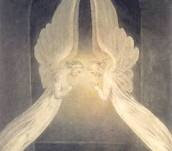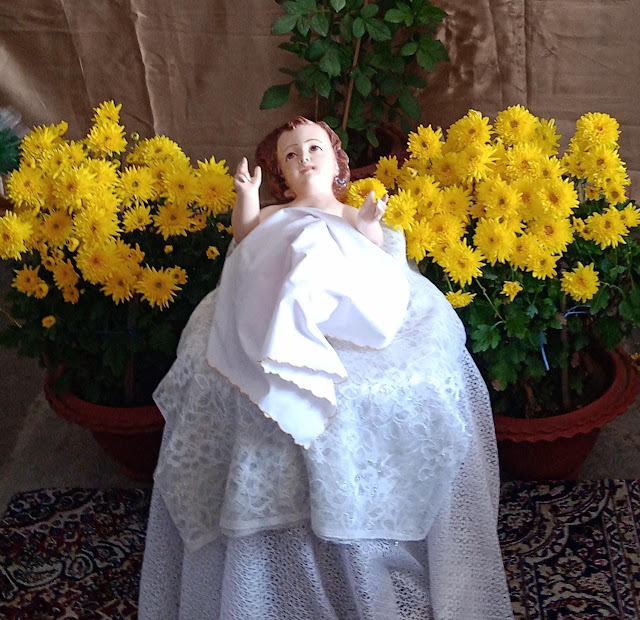When
we travel from one place to an unknown place, we look for maps or signs such as
distance guides or direction map to make sure that our destination is correct.
However, we do not stop where the signal or sign board is, because we know that
they are just symbols to lead us to our destiny. The word symbol, thus, is ‘a
mark or character that represents or stands for something else, a material
object or a function or process.’
The
word symbol came to English language from a Greek word Symbolon from the
root Syn- meaning “Together” and Bole meaning “a throw”. This
implies, “to throw together” or “coincidence.” We can also say the symbols
anticipate a reality which is in the yonder. Thus, symbols point ‘to something’
beyond what is expressed. For example, if one sees a tricolour flag with a
wheel at the centre, is understood as the National Flag of India. This flag
represents the whole of India. At the same time, reminds enormous sacrifice the
people of India went through in order to get the free Nation. It also depicts
the rich religio-cultural heritage in the form of tri-colour and wheel.
Feast
days are the special days, where we communicate ‘something’ through signs and
symbols. What we communicate could be our love, the divine love, care and
concern, prayers, etc. Let me try to enumerate a few symbolic aspects we use
during the Christmas season.
Weeks
before the actual celebration of Christmas (December 25) one can see stars
hanging on the top of the houses, shops, offices and even on the roads. Without
‘a star’ Christmas decoration is incomplete. Star is ‘the Heavenly sign of
promise’ made to humans by God himself through prophets. God promised a Saviour
who would break away the shackles of bondage and liberate the captives. And
that star is Jesus born of the Virgin Mary. Thus, the star is a fulfilment of
that promised hope.
Jesus
Himself is the greatest Star who gives light to us like the Sun who gives light
to the Earth. This is the reason Christians are celebrating the Birth of Christ
on the day of 25th December. Historically, 25th December is the
Roman Feast of Sun god. Christ being the light, gives more meaning on this day
as the light of the Universe. Thus, Christ is ‘the Star’ par excellence.
On
the day of Christmas, one of the items for decoration is varieties of beautiful
candles. Candles burn and give light to others. It is a sign of self-sacrifice
so as to give light to others. Candle represents the Christ himself, the ‘Light
of the World’ who came to ‘dispel the darkness.’ Taking Him as an example, we
too need to make our life like the candle to be the ‘saviours’ for others.
This
is another sign we use to decorate the altar, crib, walls and streets. It is
the angel who proclaimed the Good News to the Virgin Mary that she would be the
mother of the Saviour. It is the angel who gave the Good News to the Shepherds
at night that the Saviour is born. It is the angle who appeared to Magi and
instructed them to change their direction way back to their homes. Thus, the
angels symbolize the heralds of Good News. When we proclaim Good News to
others, we too become ‘angels’ for others.
In
the ancient times, to proclaim the message of a King, there used to be a
‘drummer’ who would beat the drum and proclaim the message. Thus, the drum or bell
becomes a sign or invitation to hear the ‘message.’ The Church Bell proclaims a
‘message’. This message can be of someone’s death, arrival of some dignitaries,
proclamation of a danger, or an invitation to pray or invitation to ‘return.’
To return is to return from where we have gone away from the Lord. Thus, the bells
and trumpets tell us the good news of the arrival of Jesus. When we live that
good news be become ‘bells and trumpets’ for others.
“An
Old Man with a long white beard, and with a huge bag with full of gifts and
toys” is how we describe Santa Clause. He is an attractive figure for all
children, young and old. Historically, he is known to be St. Nicholas, Bishop
of Myra (present Turkey) lived in 4th Century who had a great love
for the poor and destitute. He used to visit people at night and leave at the door
some presents for the children that they could celebrate Christmas
meaningfully. There is also a mythical story among Greek and Byzantine people
that the first day of January has been celebrated as exchanging gifts. Whatever
may be the story, the purpose is clear, “Santa represents Generosity and Good
Will of People” towards the weaker section of society.
Advent
wreath was not common till 19th Century. It is a Lutheran
initiative. It is a horizontal design prepared with evergreen green leaves and
flowers with four candles around and one in the centre. The four candles
represent four weeks of advent, and the colour of the candle being purple and
rose. The Purple colour represent the historical colour of Advent, the Rose,
the Royalty (Prince of peace). The Third Sunday of the Advent is also known as the
‘Gaudete Sunday’ meaning Rejoicing Sunday. The Fifth Candle which is at the
center is understood as the Christ and is lit on the day of Christmas. Thus,
the Advent Wreaths tell us that the coming of Saviour is near.
Christmas
Tree has a traditional history. It began in Germany almost 1,000 years ago when
St Boniface, who converted the German people to Christianity, was said to have
come across a group of pagans worshipping an oak tree. In anger, St Boniface is
said to have cut down the oak tree and to his amazement a young fir tree sprung
up from the roots of the oak tree. St Boniface took this as a sign of the
Christian faith. But it was not until the 16th Century that fir
trees were brought indoors at Christmas time. Today any coniferous tree which
is evergreen could be taken as the Christmas Tree. It is decorated with various
pictures, lights and wrappers.
Some
people also say that this tree represents the ‘paradise tree’ and therefore,
apples (round objects like balls representing first sin) and wafers (host
representing Christ’s redemption) are hanged on it. Along with this, a bright
star at the top, decorated with lights and candles shows it as the sign of
Christ. Further, its everlasting green colour represents the everlasting hope
of the mankind, and the triangular shape, tip being pointed toward sky shows
man’s thoughts and mind pointing towards heaven.
St.
Francis of Assisi, the friend of nature is credited with creating the first
Nativity Scene in 1223 in Italy. He began this in a cave with living beings,
humans and animals depicting the biblical roles. Pope Honorius III gave
official permission and blessings for this novel thought. Later, the living
beings were replaced by statues. The purpose of this physical representation in
the form of a crib is to bring to mind the actual reason why Christmas is
celebrated. This also has the effect of evangelization. The entire Jesus story
can be narrated in a pictorial form without any explanation.
Christmas
is the time children, young and old exchange gifts. Mothers at home prepare
delicious eateries. On the day or on the eve of Christmas, these sweets are
shared among the neighbouring people. This is an expression of love and
affection. This should remind us that the greatest gift that humanity ever
received is ‘Jesus Himself.’ When Jesus was born, wise kings from East came
with Gold, frankincense and myrrh as precious gifts to the Saviour. Following
this rich tradition, many people and organization distribute necessary things
for the poor. What we have, we share it with people who do not have. Thus, the
Christmas Gifts remind us of love, charity and generosity.
The
Angels sang “Glory to God in the Highest and peace to people of all kind,” at
the time of Jesus’ birth to announce the good news and to glorify God. With
this meaning today Christmas Carrols are sung everywhere. The meaning of a
carol in the present day is much different to the original one. Formerly, a
carol was a secular dance which was performed at any time of the year. People
danced around in a circle holding hands and singing songs. The dance reminded
onlookers of a coronet so they called it a 'carol'. The word Carol derives from
French language carole which means a circle dance accompanied by singers. The
name was transferred later on from the dance to the song itself. Carols by the 16th
Century were sung only at Christmas time. The subject also related to
Christmas. At one stage the Christmas carols were only sung by the bishop and
clergy in the churches. But became popular amongst the public and were soon
sung in the streets and other public places. Carol singers tell the story of
the birth of Christ in song during the days leading up to Christmas.
Baby Jesus
The
greatest and the “Meta-symbol” is Jesus Christ Himself in the form of Baby Jesus
in the Crib. He is the reason that we have all these pomp and glory. If all
other things are there and there is no Jesus, there is no Christmas. Christmas
happens everyday if we follow all the above symbols and then Jesus ever remains
in us.
Our
heart is a Crib. The size of our heart determines the size of our world. Our hearts
can contain the entire world. Isaiah speaks of ‘enlarging the tent’ (Is.
54:2-3). By our unbecoming attitudes we continuously reduce the size of our
hearts. Our accommodating nature, care and concern for the people living in the
peripheries, our willingness to help others, etc. stretch our heart so as to accommodate
several people within it. Christmas is the time we enlarge our hearts. Instead
of accommodating, we consciously push Jesus away from our hearts and thus make
our hearts small. Every day we hear a silent whisper, “Is there a place in your
Inn/Heart to let in?” What is our reply? If yes, how do we accommodate? How well
we celebrate Christmas depends on how well we open the door of our hearts.
We
may or may not use all the above said things during this Christmas or may use
things other than these. As we are using these things, let us be conscious and
aware what these signify. At the same time, we need to reflect what these
symbols signify and what they tell us? Let these signs and symbols give more
meaning to our Christmas celebration.

























.jpeg)
.jpeg)
.jpeg)

.jpeg)


.jpeg)
.jpeg)

.jpeg)



.jpeg)

